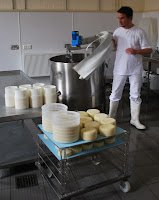 |
| Alpine pastures add to the flavour of Gruyère |
The pretty cows grazing in the Alpine pastures of Switzerland with bells round their necks are not there just for the benefit of tourists. Though this iconic scene has sold a million postcards, the milk from these hardy cattle has long been the key ingredient in one of Europe’s finest cheeses.
Made in Switzerland since at least the 12th century and named after a medieval town in the Alps, Swiss Gruyère is treasured by chefs for its versatility. Perfect for melting and baking, the cheese is an essential ingredient in such classic dishes as chicken Cordon Bleu, French onion soup and, most famously, fondue.
But it is also more than able to hold its own on the cheese boards of fashionable restaurants thanks to a complex, nutty flavour, which strikes a delicate balance between sweetness and saltiness. This rounded flavour owes much to the cows’ diet as they wander below snow-capped peaks.
“If you walk in Switzerland’s hills and valleys in the summer, you’re not just walking on grass, but pastures full of herbs and tiny Alpine flowers. This makes for marvellously sweet milk, which is one of the secrets of Le Gruyère’s flavour,” explains Maurice Johnson of Interprofession du Gruyère - the trade body that represents the 200 or so mainly small artisan dairies in Switzerland that make the cheese.
To read the rest of this article, which was first published in the April edition of Harrods Magazine, click here

